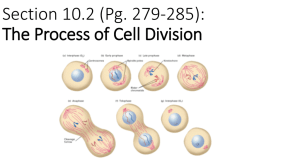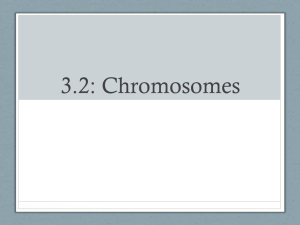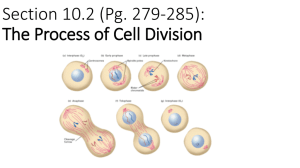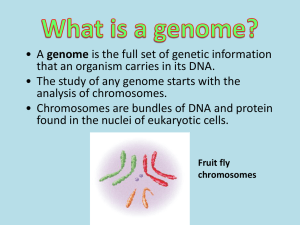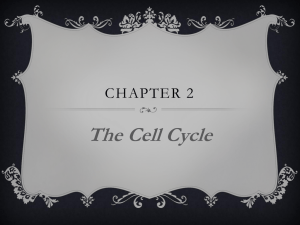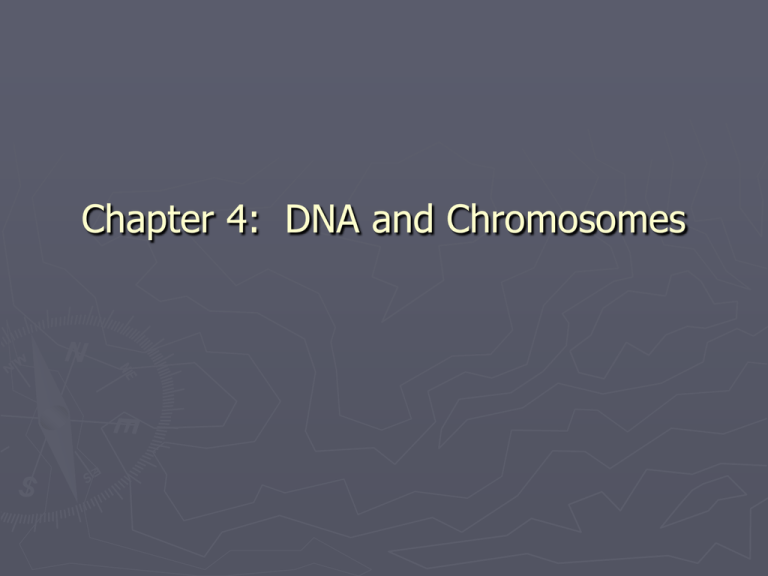
Chapter 4: DNA and Chromosomes
The Structure and Function of DNA
Scientists intrigued by chemical structure of genes
How can chemical info in genes copied and transmitted to daughter cells millions of
times, unchanged?
► How are they able to direct the development of an organism and the daily life of cell?
► What kind of instructions does genetic info contain?
► How is genetic info organized in tiny space of cell?
►
The Structure and Function of DNA
Landmark Discoveries
1940’s
1940’s
1953
1964
Studies with Fungi reveal Genetic info = instructions for making proteins
Discovery of DNA is genetic info
Structure of DNA Resolved
Genetic Code revealed
The Structure and Function of DNA
Structural Features of DNA
►
►
►
►
►
►
►
2 Complementary chains of nucleotides
A, T, G, Cs held by H-bonds
Nucelotides linked by sugar-phosphate bonds
Deoxyribose sugar
Polar 5’ phosphate linked to 3’ OH
Complementary base pairing
Antiparallel
The Structure and Function of DNA
Structure of DNA Provides Mechanism for Heredity:
Genes carry biological info that must be copied accurately for transmission
to next generation ea time cell divides
DNA encodes info through order or sequence of nucleotides
Organisms differ because of respective DNA which encodes different
biological messages
The Structure and Function of DNA
From DNA to Proteins
Properties of proteins governed by 3d structure
► Sequence of nucleotides in gene must determine
sequence of aa in protein
► Genetic code not obvious from DNA structure
►
The Structure and Function of DNA
Genome
Complete set of info in organisms DNA
► Human genome: ~50,000 distinct proteins
►
The Structure and Function of DNA
How is the Genome copied at ea cell division?
ea DNA strand can act as a template
template used as mold for synthesis of new complementary strand
The Structure and Function of DNA
DNA is housed in the nucleus
►
►
►
►
►
comprises 10% cell
Delimited by nuclear envelope with pores
Envelope contiguous w/ER
Mechanically supported by intermediate filaments of nuclear lamina and network of
intermediate filaments surrounding outer membrane
Protects and compartmentalizes
Packaging of DNA into Chromosomes
Challenges of Packaging DNA
How to get 2 meters of DNA into nucleus of 6 um
► Packaging accomplished w/ help of proteins
► Must be compacted in manner that still allows for it to be accessed by enzymes that
govern replication, transcription, and repair
►
Packaging of DNA into Chromosomes
Eucaryotic DNA is packaged into a set of chromosomes
DNA divided into set of chromosomes
► Chromosome= single DNA molecule and proteins associated with it
►
Packaging of DNA into Chromosomes
Human Chromosomes
Human DNA 3.2 x 109 bases distributed over
24 chromosomes
► Each human cell contains 46 chromosomes
►
22 homologous chromosomes
2 sex chromosomes (XX in females;
XY in males)
Packaging of DNA into Chromosomes
Bacteria have single circular DNA chromosome
Proteins pack DNA into compact structure
Proteins associated w/ processes of transcription, repair, replication
Packaging of DNA into Chromosomes
Chromosomes Contain Long Strings of Genes
►
►
►
►
►
Most impt function of chromosomes= carry genes
Gene= segment of DNA containing info for making
protein (not true for RNA molec that perform diverse
functions)
Correlation btwn complexity of organism and gene
number
Generally, more complex organisms have larger
genomes, but not always
No relationship btwn chromosome number and
complexity or genome size
Packing of DNA into Chromosomes
Most Striking Features of Human Genome
►
►
►
►
►
~30,000 gene sequences
Vast amount of non-coding DNA
Lg number of transposable elements
Lg average gene size 27,000 bp when only 1300 required to
encode avg size protein
Critical info seems to be in alarming state of disarray!
Packing of DNA into Chromosomes
Comparing DNA from Related Organisms
►
►
►
Gene Prediction difficult with all the “junk DNA”
Comparative DNA sequencing studies highlights important regions in
genome
Conserved synteny= when gene order and content is conserved
Packing of DNA into Chromosomes
Chromosomes Exist in Different States Throughout Life of Cell
Mitotic chromosomes= highly condensed chromosomes of dividing cell
► During interphase chromosomes present as extended thin threads in nucleus, not
readily visible
►
Packing of DNA into Chromosomes
Essential Features of a Linear Chromosome:
Centromere
► (2) Telomeres
► Replication Origins
►
Packing of DNA into Chromosomes
DNA is highly condensed in chromosomes
Compression of DNA performed by proteins
human chromosome 22
48 million bp
extended 1.5 cm; packed in space 0.2 um
10,000X compaction ratio
► DNA of interphase chromo less dense but overall compaction ratio
still ~1000X
► Chromosome structure is dynamic
►
Packing of DNA into Chromosomes
Chromatin= nuclear DNA plus all the proteins bound to it
Two classes of proteins bind to DNA to form chromosome
1.
histones
2.
nonhistone
Packing of DNA into Chromosomes
5 levels of Chromosomal Packaging
Packing of DNA into Chromosomes
Nucleosomes as Basic Unit of Eucaryotic Chromosome Structure
►
►
►
►
►
Discovered 1974
DNA wrapped around octameric core of histone proteins
Repeat every 200 bp
Linker DNA btwn nucleosomes ~80 bp
3x level of compaction
human DNA 6.4 x 109 bp w/ 30 million nucleosomes
Packing of DNA into Chromosomes
Characteristics of Histone Proteins
►
►
►
►
►
►
►
►
60 million/cell
Histone mass of chromosome = DNA mass
Responsible for packaging DNA into nucleosomes
4 different types: H2A, H2B, H3, H4
Highly conserved, 102-135 aa
Rich in lys and arg
Long N-terminal tail subjected to covalent modification
Specialized variant histones
Packing of DNA into Chromosomes
Histones as basic unit of nucleosomes
Interface btwn DNA and histone extensive; ~142 H-bonds
Hydrophobic and salt linkages also involved in DNA:histone
Covalent modifications of N-terminal tail of histones controls aspects of chromatin
structure
► Positioning of nucleosomes determined by DNA flexibility and other DNA bound proteins
►
►
►
short AT rich regions impart flexibility to DNA
bound proteins can facilitate formation of nucleosomes or present obstacle
►
Arrangement of nucleosomes dynamic
Packing of DNA into Chromosomes
30 nm Chromatin Fiber
Nucleosomes packed into 30 nm fiber
Fiber formation facilitated by H1 histone (histone larger than core
histones) thot to link core histones together
► Tails of core histones may attach one nucleosomes to another
► Humans 1 cm in length spans nucleus 100X
►
►
Packing of DNA into Chromosomes
ATP Driven Remodeling Complexes
►
►
►
►
►
Temporarily change nucleosome structure
Complex of > 10 subunits
Some provide acess
Others reform nucleosomes or even transfer nucleosomes
Regulation of complexes may be afforded by
phosphorylation/dephosphorylation
Packing of DNA into Chromosomes
Covalent Modification of Histone Tails
Affect stability of nucleosome
Attract specific proteins
HATs histone acetyl transferases add acetyl grps
to lys
► HDACs histone deacetylases take acetyl grps off
► Methylation of lys
► Phosphorylation of ser
►
►
►
Packing of DNA into Chromosomes
Loops and Coils
Lg loops emanate from linear chromo axis
Loops always contains same DNA
Genes in loops are actively expressed
DNA not in loops condensed in chromomeres on
axis
► Fiber converted to loop by histone modifying
enzymes, remodeling complexes and other
proteins required for gene expression
► Ea loop is independent functional domain of
chromatin structure
►
►
►
►
Packing of DNA into Chromosomes
Lampbrush Chromosomes
Meiotically paired chromo growing amph. oocytes
Packing of DNA into Chromosomes
Polytene Chromosomes of Drosophlia
►1024 identical DNA strands line up (10 cycles of DNA syn w/out cell division
►Alternating bands (95%) and interbands (5%); dynamic
►Interbands represent genes being actively transcribed
Packaging of DNA into Chromosomes
Features of Interphase Chromosomes
30 nm fiber = default structure
Histone modifying enzymes, remodeling
complexes, and other proteins resp. for converting
fiber into extended loop form when gene
expressed
► Ea loop = independent functional domain of
chromatin structure
► Chromosomes occupy distinct place in nucleus
►
►
Packaging of DNA into Chromosomes
Heterochromatin
►
►
►
►
►
diff types of condensed chromatin w/ distinct features and roles
Found in variety of organisms
Represents 10% of chromosome
Highly organized, resistant to gene expression
Resp for function of telomeres, centromeres, and may protect genome from
transposable elements
Packaging of DNA into Chromosomes
Euchromatin
Less condensed
► Composed of all types of chromatin
structures- 30 nm fibers, loops, etc
► 90% of chromatin
► transcribable
►
Packaging of DNA into Chromosomes
Gene Silencing and Position Effects
Genes relocated to region of heterochromatin
are silenced
► Position effects = when activity of gene
depends on position along chromosome
► Position effect variegation = molted expression
►
pattern results from patches of cells in which a
silenced gene has become activated or when selected
regions randomly packaged to heterochromatin and
silenced== both then are stabily inherited
Packaging of DNA into Chromosomes
Position Effect Variegation demonstrates
1.
2.
Heterochromatin is dynamic and can spread into region and later retract
Whether heterochromatin or euchromatin can be inherited
Packaging of DNA into Chromosomes
Special Form of Heterochromatin at Chromosomal Ends
Chromatin region extending 5,000 bp from chromo ends resistant to gene expression
Many diff proteins required for special folding
Mutations in silent information regulator proteins (SIR) prevent silencing of genes near
telomeres
► Cooperative binding of SIRs occurs to facilitate modifications
►
►
►
Packaging of DNA into Chromosomes
SIRs
►
►
SIRs types
1. recognizes underacetylated N-terminal tails of selected histones
2. SIR2 = conserved histone deacetylase- deacetylation of histone
tails thot to allow tighter packaging of nucleosomes that are less
susceptible to remodeling complexes
SIR2 requires NAD+ cofactor; NAD+ levels fluctuate w/ nutritional
status of cell increasing under nutritional deprivation
Packaging of DNA into Chromosomes
Mitotic Chromosomes= Chromatin in Most Condensed Form
Packaging of DNA into Chromosomes
Mitotic Chromosomes= Chromatin in Most Condensed Form
10x smaller than interphase chromosomes
► Function
1.
compaction protects fragile DNA from breaking
2.
allows sister chromatids to be easily separated by mitotic apparatus
► Condensin proteins use ATP to drive coiling of interphase chromosomes
► Characteristic pattern of condensed AT rich regions and less condensed CG rich
regions- geisma staining
►

